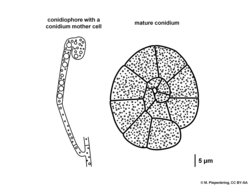Hobsonia
Topic: Biology
 From HandWiki - Reading time: 2 min
From HandWiki - Reading time: 2 min
| Hobsonia | |
|---|---|

| |
| Hobsonia mirabilis, drawing of conidiophore and coiled conidium | |
| Scientific classification | |
| Domain: | Eukaryota |
| Kingdom: | Fungi |
| Division: | Basidiomycota |
| Class: | Atractiellomycetes |
| Order: | Atractiellales |
| Family: | Phleogenaceae |
| Genus: | Hobsonia Berk. ex Massee (1891) |
| Type species | |
| Hobsonia gigaspora Berk. ex Massee (1891)
| |
Hobsonia is a genus of fungi in the family Phleogenaceae.[1] The genus is currently monotypic, with a single recognized species, Hobsonia mirabilis. The type species, H. gigaspora, and H. ackermannii are considered to be synonyms[2] and additional lichenicolous species have now been transferred to the ascomycete genera Hobsoniopsis and Illosporiopsis.[3] Hobsonia mirabilis is only known in its anamorph form, which is whitish, gelatinous, pustular, and occurs on dead woody plant remains. Microscopically, it produces coiled or spiralled conidia.[2] The species was formerly of uncertain disposition, but molecular research, based on cladistic analysis of DNA sequences, has shown that it belongs within the Atractiellales.[1][4] Though originally described from New York, the species is more commonly found in the tropics and subtropics.[2]
References
- ↑ 1.0 1.1 Wijayawardene, Nalin; Hyde, Kevin; Al-Ani, Laith Khalil Tawfeeq; Somayeh, Dolatabadi; Stadler, Marc; Haelewaters, Danny et al. (2020). "Outline of Fungi and fungus-like taxa". Mycosphere 11: 1060–1456. doi:10.5943/mycosphere/11/1/8.
- ↑ 2.0 2.1 2.2 Martin, G. W. (1959). "On the genus Hobsonia". Brittonia 11 (2): 98–101. doi:10.2307/2805177. Bibcode: 1959Britt..11...98M.
- ↑ "The phylogenetic position of selected lichenicolous fungi: Hobsonia, Illosporium and Marchandiomyces". Mycological Research 105 (4): 453–460. 2001. doi:10.1017/S0953756201003768.
- ↑ "Two new endophytic Atractiellomycetes, Atractidochium hillariae and Proceropycnis hameedii". Mycologia 110 (1): 136–146. 2018. doi:10.1080/00275514.2018.1446650. PMID 29863992.
Wikidata ☰ Q10524991 entry
 |
 KSF
KSF